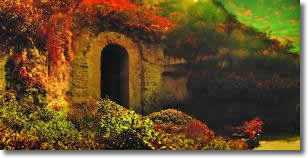Warning! The template for this page [TurismoCultura.html] doesn't exists.
Mythical and legendary origins of the city
This section begins with the legend of the beautiful siren Parthenope who landed on the coast of a fertile land with a mild climate.
Her legend intertwines with the founding of Naples, the myth of the god Mithras, the Isis mysteries, the cult of Priapus and the fantasy story of Colapesce, until we get to the "talking statues", a "symbol" of the city.
The Siren Parthenope
The origins of the city of Naples, maritima urbs, as Tito Livio referred to it, are firmly rooted in the myth of the Siren Parthenope. The story begins on the island of Megaride where, according to legend, the original nucleus of the city called Parthenope originated. According to ancient sources, this small settlement lay near the tomb of the young siren who had lived in the seas around the Sorrento peninsula.
Mithra And The Carminiello Ai Mannesi Thermal Complex
There is ample evidence to suggest that ancient oriental cults were popular in Naples. One of these centred around the god Mithra, and is linked to an Imperial Roman Age thermal complex which was found in the Via Duomo area.
The ancient complex covered an area the size of an insula, bound to the North and South by the central and southern decumanus (Via Tribunali and Via San Biagio dei Librai today)...
The Isiaci Mysteries
The mysteries surrounding the goddess Isis are some of the most important and closely-guarded secrets of Neapolis. The goddess was associated with the moon, and once you realise how powerful and involving the moon rituals organised by the alessandrini community who lived in Naples during the Roman period were, - night-time rituals linked to the waxing and waning of the moon - you understand how much the Neapolitans loved the moon and the night...
The cult of Priapus
The horn is the most famous symbol of Neapolitan superstition. Lots of doors and balconies sport huge bunches of red peppers instead, because their hot seeds symbolically ward off evil tongues. We no longer remember what the horn really means. We touch it without knowing why. Yet the horn is none another than a stylisation of a phallus, that of the Grecoroman god Priapus, guardian of the lands, protector from the evil eye and god of prosperity, the house and fishing...
Colapesce
The legend of Niccolò Pesce, known as Colapesce or "Nick the Fish" he was such a good swimmer, originated in the Middle Ages. It was said that the young man had webbed fingers, fins and scales: half man and half fish, he could live at the bottom of the sea. Legend has it that Niccolò Pesce, when he wanted to travel long distances, got a huge fish to swallow him and then, when he got to where he wanted to be, cut open the belly of the fish and climbed out...
The Sebeto river
Sebeto: a mythical name which takes you back to the first settlements in Naples. It's original name Sepeithos, can be found on a few coins produced between V and IV centuries B.C. The river must have been quite big for the people of the time, following the tradition and technique of other races, to choose it as their local river god and portray it as a young man next to Parthenope...
The "talking statues"
Neapolitan works of art have always held a special place in the collective imagination. Nobody even remembers the sayings and legends associated with the "talking statues" like 'O Cuorpo 'e Napule, Donna Marianna, the Gigante di Palazzo and the Testa Carafa.
'O Cuorpo 'e Napule: the Nile Statue
The history of Naples is richly interwoven with stories linked to the existence of foreign communities who had settled in Naples for reasons of trade and commerce. A group of merchants and sailors from Alexandria in Egypt settled in the area to the far East of the lower plateia of Neapolis, known as piazzetta Nilo today.
Marianna, 'a Capa 'e Napule
In Palazzo San Giacomo, at the top of the main staircase, you can see a marble head of a woman, which is the copy of a classical sculpture which had been found near Piazza Mercato in XVII century. It is one of the most mysterious and evocative pieces of antique art in the city of Naples. According to Carlo Celano in his book Notizie del bello, dell'antico e del curioso della città di Napoli and to Giovanni Antonio Summonte in Historia della città e Regno di Napoli, who were both alive when the statue was found, tradition has it that the woman's head was of the Siren Parthenope.
'O Gegante 'e palazzo and Neapolitan satire
The famous statue known as the "Palace Giant", which stands in the gardens of the National Archaeological Museum, is an imposing marble bust which used to stand on the steps leading up to the Museum entrance. Its base had an inscription reading Busto di Giove da Cuma or Bust of Jupiter of Cumae...
The "Testa Carafa"
In XVII century, the idea that the famous Carafa head belonged to the bronze equestrian statue that Virgil the Magician had made, grew in popularity. According to popular belief, the statue had the power to cure sick horses. In reality, the Carafa head was not part of the mythical group of horses which was destroyed in 1322 because it had become a source of popular superstition...

 read all
read all